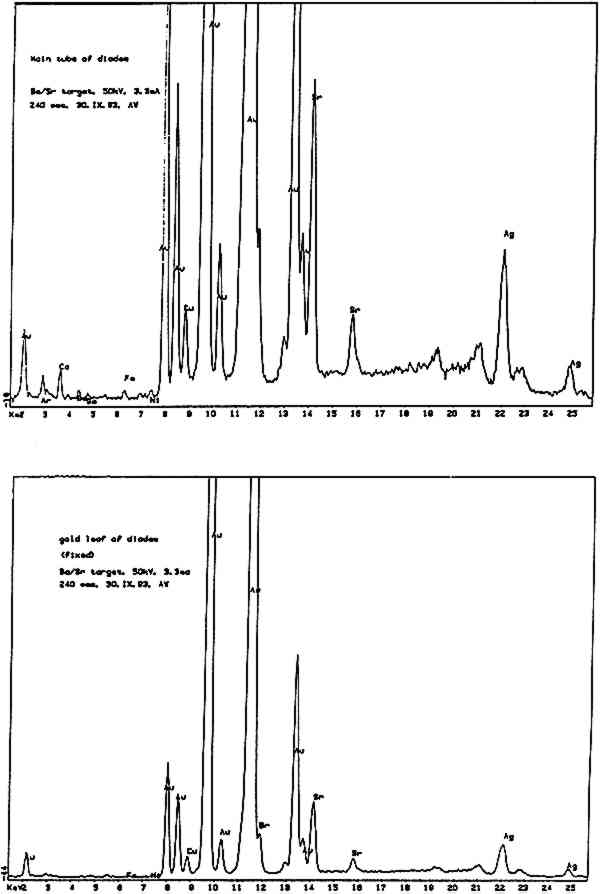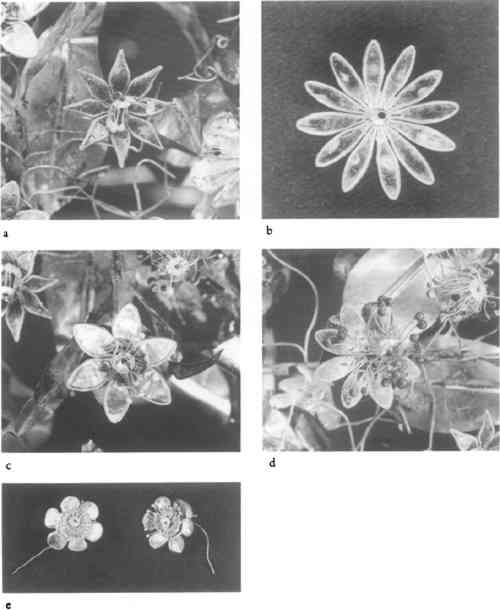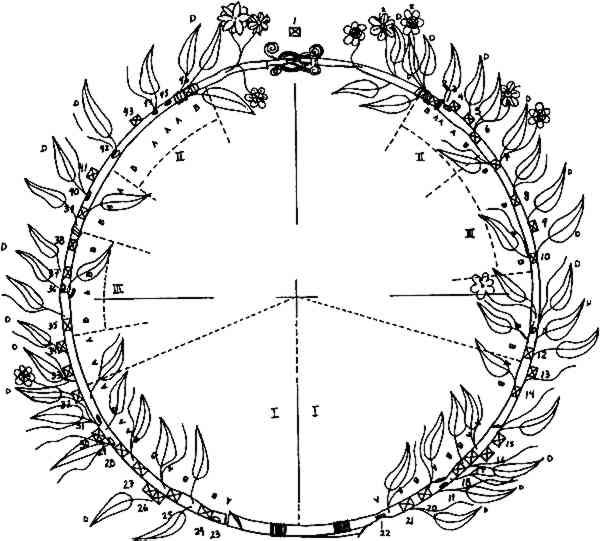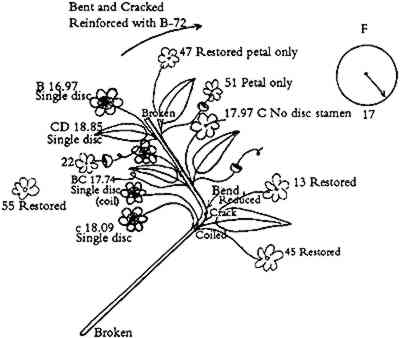INTERPRETATION OF ANCIENT ARTISTRY: CONSERVATION OF A GOLD WREATH FROM THE FOURTH CENTURY B.C.JEFFREY P. MAISH
3 INFORMATION OFFERED BY THE ARTIFACT3.1 AUTHENTICITYX-ray fluorescence analysis of several locations on the wreath (fig. 3) suggests a gold-copper alloy consistent with ancient gold production methods (Scott 1993). The construction methods were similar to those employed on other wreaths. The sophisticated craft techniques included a construction method in which melting points used by separate manufacturing steps may have been successfully lowered.
3.2 STATE OF PRESERVATIONOur decision-making process depends in a large part on the state of the object's preservation. In some situations, specific details from one area of an artifact may therefore be used to reconstruct another area. This artifact's structure, intricate yet also repetitive, enabled some technical information to be transferred. A technical survey of the wreath aided in establishing its degree of completeness. The survey of the main support tube showed that out of 46 possible spikes or points of attachment for branches, only 26 branches remained. What were initially 3.3 TECHNICAL FEATURESInitially, wire and foil were manufactured through methods that included hammering, stamping, twisting, and coiling. Segments of the manufacture such as foil and wire production could have been independent operations, although these components also may have been part of the wreath production method. Lengths of twisted wire would have been produced by rolling thin strips of gold foil into small, tightly coiled tubes. More detailed components such as the flower petals and stamens could have been formed in large quantities at an early stage for later assembly into complete flowers. The main support of the wreath was formed from two curved and tapered tubes. Spikes were then soldered on for the tubes of the branches (fig. 4). The two tube halves were joined at the rear with wire looping and at the front with a decorative Herakles knot (fig. 5). The branch stems were formed separately from smaller diameter tubes. Heavier gauge wires were inserted through punched holes in the tubes and then flattened and trimmed to form leaves. Flowers were assembled on wires that had been previously attached to the branch tubes. Each flower consists of three or possibly four components including a hemispherical support, a group of petals, and either a wire stamen or a single or double ring disc. In some instances a plasterlike core remained in the interior of the hemispherical portion of the flower. The plaster core may have supported the gold foil during forming but probably also gave the flower further structural support, or its added weight may have played an aesthetic role by allowing the flowers to sway. The petals may have been produced by stamping. The regularity of the shapes and sizes, suggests stamping, as do the matching outlines of two petal groups on one stem. A gradual bowing of the flowers' profiles also suggests stamping or punching.
Soldering and heating most probably was carried out in a small oven capable of approximating the melting point of fine gold at 1063�C (Untracht 1975). The stamens (fig. 6) were produced using the following techniques in succession. After the preliminary mechanical working was completed, the artisan might have executed higher-temperature forming to shape the rounded tips of a stamen, followed by lower-temperature joining of individual parts of the wreath. Finally, a low-melting-point glass was added to some areas. Anthers of blue glass globules were fused to the tips of some wire stamens, and blue glass was added to color several flower petals. Bubbles or “seeds” in the glass are highly suggestive of lower-temperature work (Newton and Davison 1989). In addition to gas bubbles, environmental Scanning Electron Microscopy inspection of the glass surface (fig. 7) of one petal group shows the incomplete mixing of the glass components, another indication of fairly low-temperature glass working.
3.4 AESTHETICSome contemporaneous Lucanian wreaths from the fourth century B.C. include fanciful details in their design (Deppert-Lippitz 1985). Ornate elements such as star-shaped flowers and erotes, in one example, contrast with the more naturalistic aesthetic of the Getty wreath, which belongs to a group of wreaths possessing a significant degree of botanical accuracy When compared in photographs to a real myrtle branch, the accurate details of the Getty wreath can be seen to include the shape of the flowers and the leaves. The variable leaf size and tapering stem diameters also suggest natural growth patterns (Polunin 1969). This tradition of the naturalistic representation of plant life also seems to have included depictions of ivy, oak, and olive branches. In a departure from absolute naturalism, the creator of the Getty wreath has inserted a mixed grouping of colored glass flowers at the front variously described as gentian or campanula, and even one example of a presumably imaginary flower with alternating blue and green petals (fig. 8).
Despite the seemingly random organization of the wreath, a careful examination revealed an underlying design. Spikes were soldered to the main branch tube in a roughly symmetrical pattern with some branches facing upward and forward, while others faced upward, forward, and slightly outward (fig. 9). It follows, therefore, that the branches, too, were arranged in a distinct pattern. Symmetrical placement is also found in the individual branches in which leaves were positioned opposite one another. The sum of the parts of the wreath was combined, however, to create a naturalistic and aesthetically gratifying design.
Each of the wreath's 26 individual branches was sketched, numbered, and mapped for technical features (fig. 10). The approximate sizes of the flowers were measured as well, and four distinct dimensions were noted as A, B, C, or D with sizes ranging from 15 to 20 mm. This range indicates that the artisan was interested not only in depicting a wreath but also in creating branches with variable vertical growth. Flower sizes were also noted by quadrant to show their horizontal distribution. One quadrant in particular was “depleted” of flowers. Although they were not surveyed, several leaf sizes could be noted on the wreath as well. Different design elements were also noted. Stamens, for example, were either of the less
To all of this one may add the depredations of time, arising from the object's own chemical composition and its environment. In this case the surface alteration was generally minimal and confined to a light calcareous layer on some leaves. Several of the flowers, however, appear to have a high mirrorlike finish on one side (fig. 11). The question remains as to whether this effect is a result of an intentional finishing process, variable weathering during burial, or perhaps an uneven cleaning |







